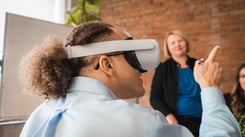The process for sharing architecture projects varies from firm to firm and project to project. There can be a lot of information and visuals to share, and you want to ensure your project gets into the hands of your clients as easily as possible. Here at Yulio, we believe VR architecture projects are the future of sharing your projects with as much clarity as possible. Top that off with the fact that sharing your VR architecture projects with Yulio could not be easier.
Discover how Yulio revolutionizes the sharing of VR architecture projects with ease and efficiency and the tools we offer to enhance your client’s VR experience.
Exploring the Benefits of Yulio for Architects
Yulio provides architects with a powerful platform to easily share their VR architecture projects. By using Yulio, architects can showcase their designs in a realistic and immersive virtual reality experience. This allows clients, stakeholders, and other architects to fully visualize and understand architectural concepts with as much clarity as possible.
One of the key benefits of Yulio is the simplicity of sharing your projects. Architects can easily share their VR architecture projects with others by generating a simple link. This link can be shared via email, messaging apps, or social media platforms. It eliminates the need for complex file transfers or installations, making the sharing process hassle-free.
Additionally, Yulio offers the option to embed VR architecture projects on a webpage. This enables architects to seamlessly integrate their designs into their websites, portfolios, or online presentations. It provides a convenient way for visitors to explore the VR experience directly on the architect's own platform. We even recommend using this feature to set up an online virtual portfolio to display your work to interested clients.
Yulio also allows architects to send their VR architecture projects directly to users' headsets. This enables a more personalized and immersive experience, as users can view the designs in full VR.
How to Share VR Architecture Projects with Yulio
Sharing VR architecture projects with Yulio is a straightforward process that only takes a few steps. Architects can follow these simple steps to share their designs:
- Create a Yulio account: Architects need to sign up for a Yulio account to access the platform's features and services. We currently offer a 30-day free trial for interested users.
- Upload the VR architecture project: Once logged in, architects can upload their VR architecture projects to the Yulio platform. You can check our upload requirements, but we accept many different formats and have compatibility with a wide arrangement of software such as Revit, CET Designer, 3DS max and other renderers such as Enscape. We also have several plugins that allow you to cloud render your projects, cutting down on rendering time for yourself.
- As soon as your project is uploaded you can start sharing your project right away! Right away architects can generate a unique sharing link for their project. This link can be easily shared with clients, stakeholders, or anyone they want to share the VR architecture project with.
By following these steps, architects can easily share their VR architecture projects with Yulio and provide an immersive and interactive viewing experience for their clients and stakeholders. However, with Yulio, you can further enhance your VR projects with many of Yulio’s features.
Customizing VR Experiences with Yulio's Features
Yulio offers a range of features that allow architects to customize their VR experiences and create immersive presentations. These features include:
- Interactive Elements: Architects can add interactive elements to their VR architecture projects, such as clickable hotspots, menus, or buttons. This enables users to engage with the design, explore different views, or access additional information.
- Hotspots: Yulio allows architects to add annotations to specific areas or objects within the VR experience. Annotations can include text, images, or even audio recordings. This helps architects highlight key details or provide additional context to viewers.
- Custom Branding: Yulio allows architects to customize the branding of their VR architecture projects. Architects can add their logo, colors, and other branding elements to maintain a consistent visual identity throughout the VR experience.
By utilizing these features, architects can create unique and engaging VR experiences that highlight their designs in the most effective and impactful way.
Enhancing Collaboration and Communication in VR Architecture
One of the key advantages of using Yulio for collaboration is the ability to provide real-time feedback in our Collaborate mode feature. With Yulio, architects can collaborate with clients, stakeholders, and other architects in a virtual reality environment, enabling a more efficient and effective design process.

Clients and stakeholders can immerse themselves in the VR architecture project and provide immediate feedback on the design, materials, lighting, and other elements. This can include marking up the project in real time to ensure nothing is lost in the conversations with clients. This facilitates a more iterative design process and ensures that everyone's input is considered. Yulio also enables architects to conduct virtual meetings and remote presentations. This can eliminate the need for physical meetings and allows for more flexible and convenient collaboration, especially when working with clients who may live far away.
If you want tips and tricks on how to get started using Yulio with Revit or other programs, check out our guide to creating your VR projects. And try our 30-day free trial to get acquainted with Yulio and all its powerful features.







